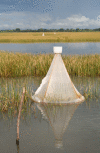Identifying the most productive breeding sites for malaria mosquitoes in The Gambia
- PMID: 19361337
- PMCID: PMC2674466
- DOI: 10.1186/1475-2875-8-62
Identifying the most productive breeding sites for malaria mosquitoes in The Gambia
Abstract
Background: Ideally larval control activities should be targeted at sites that generate the most adult vectors, thereby reducing operational costs. Despite the plethora of potential mosquito breeding sites found in the floodplains of the Gambia River, about 150 km from its mouth, during the rainy season, only a small proportion are colonized by anophelines on any day. This study aimed to determine the characteristics of larval habitats most frequently and most densely populated by anopheline larvae and to estimate the numbers of adults produced in different habitats.
Methods: A case-control design was used to identify characteristics of sites with or without mosquitoes. Sites were surveyed for their physical water properties and invertebrate fauna. The characteristics of 83 sites with anopheline larvae (cases) and 75 sites without (controls) were collected between June and November 2005. Weekly adult productivity was estimated with emergence traps in water-bodies commonly containing larvae.
Results: The presence of anopheline larvae was associated with high invertebrate diversity (Odds Ratio, OR 11.69, 95% CI 5.61-24.34, p < 0.001), the presence of emergent vegetation (OR 2.83, 95% CI 1.35-5.95, p = 0.006), and algae (at borderline significance; OR 1.87, 95% CI 0.96-3.618, p = 0.065). The density of larvae was reduced in sites that were larger than 100 m in perimeter (OR 0.151; 95% CI 0.060-0.381, p < 0.001), where water was tidal (OR 0.232; 95% CI 0.101-0.533, p = 0.001), vegetation shaded over 25% of the habitat (OR 0.352; 95% CI 0.136-0.911, p = 0.031) and water conductivity was above 2,000 muS/cm (OR 0.458; 95% CI 0.220-0.990, p = 0.048). Pools produced the highest numbers of Anopheles gambiae adults compared with rice fields, floodwater areas close to the edge of the floodplain or close to the river, and stream fringes. Pools were characterized by high water temperature and turbidity, low conductivity, increased presence of algae, and absence of tidal water.
Conclusion: There are few breeding sites that produce a high number of adult vectors in the middle reaches of the river in The Gambia, whereas those with low productivity are larger in area and can be found throughout the rainy season. Even though risk factors could be identified for the presence and density of larvae and productivity of habitats, the results indicate that anti-larval interventions in this area of The Gambia cannot be targeted in space or time during the rainy season.
Figures







Similar articles
-
Anopheles larval species composition and characterization of breeding habitats in two localities in the Ghibe River Basin, southwestern Ethiopia.Malar J. 2020 Feb 11;19(1):65. doi: 10.1186/s12936-020-3145-8. Malar J. 2020. PMID: 32046734 Free PMC article.
-
Agriculture and the promotion of insect pests: rice cultivation in river floodplains and malaria vectors in The Gambia.Malar J. 2009 Jul 27;8:170. doi: 10.1186/1475-2875-8-170. Malar J. 2009. PMID: 19635125 Free PMC article.
-
Spatial distribution of mosquito larvae and the potential for targeted larval control in The Gambia.Am J Trop Med Hyg. 2008 Jul;79(1):19-27. Am J Trop Med Hyg. 2008. PMID: 18606759
-
Dry season ecology of Anopheles gambiae complex mosquitoes at larval habitats in two traditionally semi-arid villages in Baringo, Kenya.Parasit Vectors. 2011 Feb 28;4:25. doi: 10.1186/1756-3305-4-25. Parasit Vectors. 2011. PMID: 21352608 Free PMC article.
-
Field site selection: getting it right first time around.Malar J. 2009 Nov 16;8 Suppl 2(Suppl 2):S9. doi: 10.1186/1475-2875-8-S2-S9. Malar J. 2009. PMID: 19917079 Free PMC article. Review.
Cited by
-
Charaterization of mosquito larval habitats in Qatar.Saudi J Biol Sci. 2020 Sep;27(9):2358-2365. doi: 10.1016/j.sjbs.2020.07.006. Epub 2020 Jul 10. Saudi J Biol Sci. 2020. PMID: 32884417 Free PMC article.
-
Characterization of the anopheline vector breeding habitats: Implications for elimination of malaria in tribal inhabited Car Nicobar Island.Indian J Med Res. 2022 Aug;156(2):240-249. doi: 10.4103/ijmr.ijmr_3189_21. Indian J Med Res. 2022. PMID: 36629183 Free PMC article.
-
Anopheles larval species composition and characterization of breeding habitats in two localities in the Ghibe River Basin, southwestern Ethiopia.Malar J. 2020 Feb 11;19(1):65. doi: 10.1186/s12936-020-3145-8. Malar J. 2020. PMID: 32046734 Free PMC article.
-
Agriculture and the promotion of insect pests: rice cultivation in river floodplains and malaria vectors in The Gambia.Malar J. 2009 Jul 27;8:170. doi: 10.1186/1475-2875-8-170. Malar J. 2009. PMID: 19635125 Free PMC article.
-
Distance to Anopheles sundaicus larval habitats dominant among risk factors for parasitemia in meso-endemic Southwest Sumba, Indonesia.Pathog Glob Health. 2014 Dec;108(8):369-80. doi: 10.1179/2047773214Y.0000000167. Epub 2014 Dec 10. Pathog Glob Health. 2014. PMID: 25495283 Free PMC article.
References
-
- Kitron U, Spielman A. Suppression of transmission of malaria through source reduction: antianopheline measures applied in Israel, the United States, and Italy. Rev Infect Dis. 1989;11:391–406. - PubMed
-
- Russell PF. Man's mastery of malaria. London: Oxford University Press; 1955.
-
- Soper FL, Wilson DB. Anopheles gambiae in Brazil. New York: The Rockefeller Foundation; 1943.
Publication types
MeSH terms
Substances
Grants and funding
LinkOut - more resources
Full Text Sources
Medical

